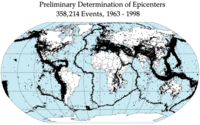
Photo from wikipedia
Abstract Re-compaction process after previous liquefaction exerts significant effects on subsequent cyclic behaviour of soil. Due to the complexities in environmental loading conditions, the relevant studies on this topic are… Click to show full abstract
Abstract Re-compaction process after previous liquefaction exerts significant effects on subsequent cyclic behaviour of soil. Due to the complexities in environmental loading conditions, the relevant studies on this topic are limited. In this paper, we collected natural submarine silts from non-liquefied and post-liquefied seabed in the Yellow River subaqueous delta via offshore hydraulic sampling method, respectively. Monotonic and cyclic triaxial tests were conducted between them to investigate the re-compaction effect after previous wave-induced liquefaction on the undrained static and cyclic shear behaviours of seabed soil. Our experiments indicated that due to re-compaction process, the static and cyclic strengths of seabed silt in post-liquefied area are both enhanced in comparison to non-liquefied soil. A transformation in static shear failure mode from plastic to brittle after wave-induced liquefaction could be identified in seabed silt. Furthermore, the developments of pore water pressure and cyclic axial strain with number of cycles for seabed silts could be characterized by the hyperbolic and power models, respectively, and an empirical relationship between pore water pressure and cyclic axial strain is proposed for natural seabed silt. Finally, compared with non-liquefied seabed silt, the threshold cyclic stress ratio (CSR) for post-liquefied seabed silt is also elevated due to re-compaction effect.
Journal Title: Ocean Engineering
Year Published: 2020
Link to full text (if available)
Share on Social Media: Sign Up to like & get
recommendations!